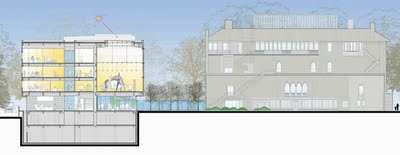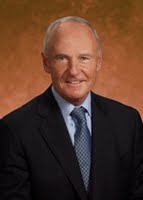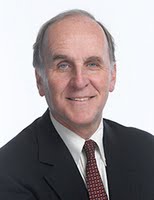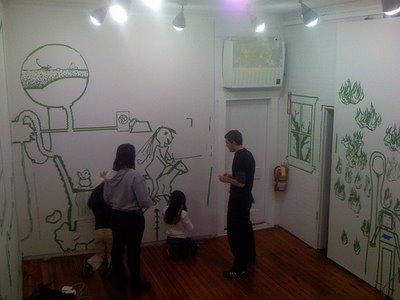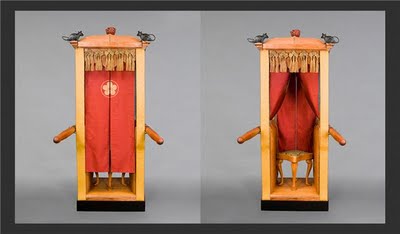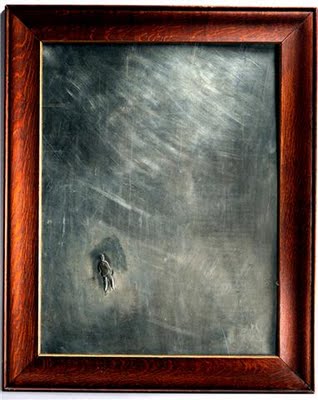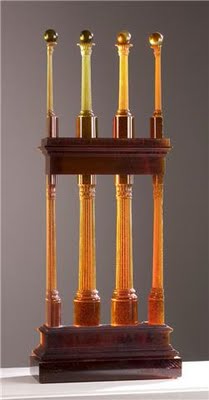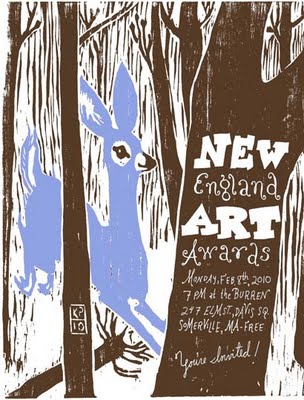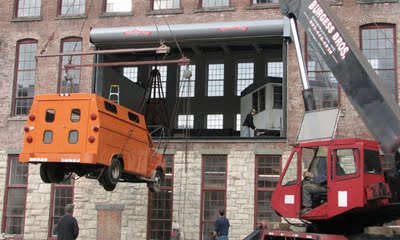
Bread and Puppet’s
“Tear Open the Door of Heaven,” which the Vermont troupe performed at the Boston Center for the Arts from Jan. 28 to 31 and in New York City in December, is an omnibus show touching on God, revolution, a savior, mining by mountain top removal, Iraq, enhanced interrogation techniques, Gaza, and an unemployment agency’s “ever-growing clientele.” At first viewing, it feels all over the place, a list of concerns that are not necessarily related. But upon reflection, it seems perhaps to be about faith – faith in what our government tells us, faith in business, faith in religion, faith in Heaven, or at least some sort of ancient elemental form of ecstasy.
It begins with a prologue, narrated by Bread and Puppet founder Peter Schumann at the back of the audience. “The stars predict revolution in the immanent future,” he says while manipulating various flat cardboard and cloth figures and crowds. “The government takes preemptive action against the imminent future. One is saved and therefore is made the savior. The people’s eyes are asleep. The savior tears them open. He pronounces revolution. The people faint. The government arrests the savior. And the people walk over his arrested body. When the savior is dead his star rises. And the people follow the star. And then the situation is about to return.”
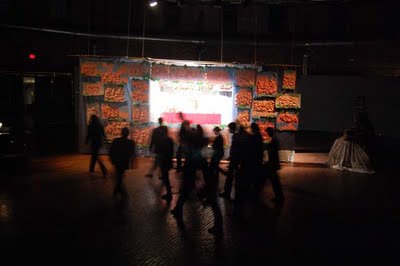
The show then gets underway, focused on a box stage that resembles a sort of caricature of a television, and framed by cardboard panels decorated with papier-mache relief crowds of figures. To the right stands a chorus of performers in dark suits. To the left a narrator in a dark suit stands at a music stand. “God, his daughter and stepdaughter preside over dynamic quantities of light,” she says, “and order reasonable and unreasonable distribution of light and darkness.” Schumann saws away at his violin while doing a kind of growly throat singing. Inside the stage, behind a clear plastic curtain, three giant pink papier-mache faces seem to drift in the air, and are joined by little floating crowds of papier-mache people. The gorgeous vision is apparently a glimpse into heaven.
Again to the box stage, where a performer in a gray mask and long black coat conducts a brief dance of feet (performers on their backs peddling their legs in the air). A woman comes out of the chorus, erects a bare tree in the center of the stage, and announces, “The first dance intervention is the Boston rush hour crowd forest admiration dance.” The chorus shuffles to the tree, kneels down, raises their hands in exaltation, then shuffles back to the right. (The show’s six dance “interventions by the Lubberland National Dance Company” recycle almost the entire
“13 Dirt Floor Cathedral Dances” show that Bread and Puppet performed at its home base in Glover, Vermont, last summer.)
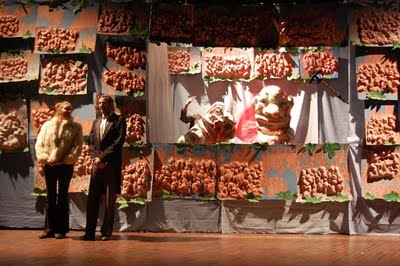
The narrator announces: “Mountaintop removal protesters confront mountaintop removal machinery.” A broom and rake repeatedly clobber two large clown-like faces in the box stage, as a man and woman of the “Ta-ta-ta choir” sing operatically. The narrator concludes: “Minor consequences, a few tractors demolished, a few heads busted. One regional prison is flooded with surplus population elements.”
A small puppet show follows in the box stage, featuring a shepherd (seemingly just a rumpled handkerchief) and rumpled paper sheep climbing a green blanket mountain. Narrator: “Sheep-like clouds issue from a crack in the door of heaven. When the shepherd reaches the not yet removed top of the mountain, his flock joins the flock of clouds and becomes part of the sky.” Schumann sings: “Oh you brother sun with your arms stretched over the horizon! Oh you pink sky in your fancy evening coat! Oh you fast-traveling day beneath my fleeing pasture! I don’t want to leave you! I don’t’ want to be without you!”
Narrator: “Eternity University behind closed doors. Heavenly boredom lecture, taught by God’s stepdaughter.” As two violinists play, in the box stage another glimpse of heaven: Little floating crowds of papier-mache people are joined by a single hovering giant pink head that slowly wiggles back and forth.
The woman comes out of the chorus again and announces: “The second dance intervention is a deforestation dance to create parking for deforesters.” In unison, the chorus raises their hands behind the tree at center stage, hugs it, shakes it, pulls it down and then drags it off stage.
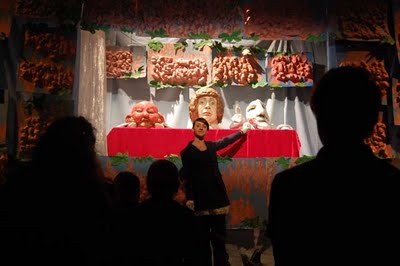
Three mask heads sit behind a red table on the box stage: the Desert Storm Potentate, his wife, and the Secretary of Everything. They bicker over a meal of ham, until the Secretary interrupts, saying “Can we now proceed?” Potentate: “With what?” “With the perpetrators.” “Sure, why not.” “Just like that … in broad daylight?” “Sure” “Start the procedure.” A large brown papier-mache body drifts down, hiding them.
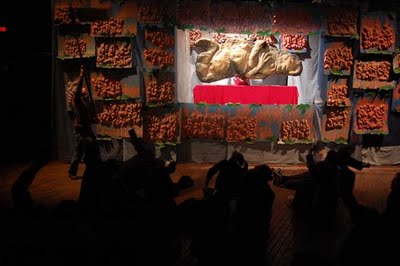
A man comes out with a device on the end of a stick. He swings it around and it makes a loud clacking. The chorus members, seated before the box stage, each awkwardly bend their left arm around in the air. Little flat clown puppets pop up before the red table and quiz each other: “Do you believe?” “Yes, I do believe.” “Do you believe?” “No I don’t believe.” “Then take that!” And each one is stabbed by scissors in turn. “Now I beeeliievee,” the wounded puppets groan.
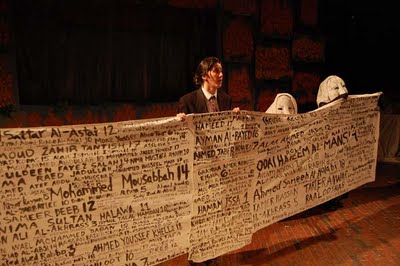
As the chorus blows on empty bottles to make a hooting noise, the woman comes out of the chorus again and announces: “The third dance intervention is a pillow dance and this dance is dedicated to the children of Gaza who were killed in last January’s attacks.” She is joined by three performers costumed as women in large white masks, white head scarves, and black gowns. They unfurl a banner scrawled with the names of the dead. (I first saw this banner used in
“27 Dirt-Cheap Money Dances” in Boston last March.) The chorus woman folds the banner into a pillow. One of the masked women lays down on it. A solder marches past robotically. The woman is helped up by her partners.
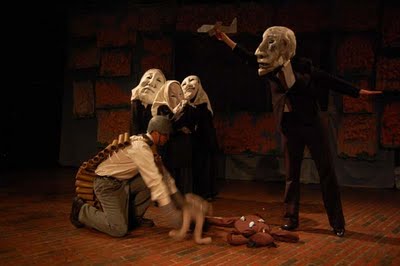
A man in a white mask and dark suit emerges from the chorus holding a cardboard airplane. The chorus hums ominously. The man with the plane freezes. The solder dashes out and places a stuffed doll body on the ground below, like the corpse left by a bombing. The women try to exit, but are interrupted by the man with the plane and the soldier bringing a body twice more. Finally they exit.
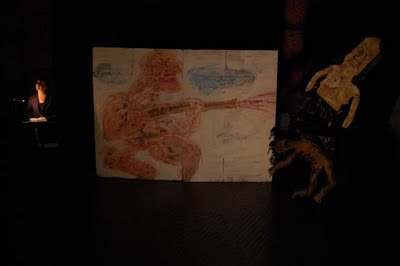
Narrator: “Strategic exercises by pedestrians to tear open the door of Heaven.” In the box stage, a runner jogs while observed by a doctor, both of them wearing Groucho Marx masks. Then the announcer stands spot lit at center stage, next to a painting on a large sheet of cardboard of large fleshy man firing a gun. And next to the painting is a flat cardboard puppet of a topless woman and an anguished child – a sort of Pieta. The announcer says: “Peace-loving war-mongers make preparations for victory. Cemeteries for victory’s spoils have to be adequately constructed. Military solutions to otherwise merely local and locally confined conflicts have to be invented. … Even the most atrociously maimed bodies of the alleged innocent cannot distract from the basic truth: war is peace. … The dissemination of organized truth is an essential part of the effort. The public wants to and must share in its government’s accomplishments.”
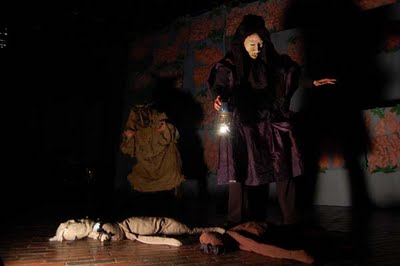
The woman comes out of the chorus again and announces: “The fourth dance intervention is the dance of the foolish woman who tries to bring back to life the children who were killed in Gaza.” A man in a dark cloak carrying a lantern enters the darkened stage. He reveals a horned figure hiding under his coat. They study the bodies left by the soldier. They drag a woman in white with long blonde hair onto the stage. (The character is a variation of the angel who resurrects the slaughtered horse at the end of “The White Horse Butcher” shows of the mid 1970s, a character which developed from earlier suffering or savior angel White Ladies.) One by one, she carefully picks up the bodies, then dances wildly with them, swinging her rope hair about, then throws the dead body back down. The lantern man and the horned creature finally pull her off stage. They return. The lantern man picks up one of the bodies and places it into a wheelbarrow brought on stage by a man in the chorus, who trails the rest of the chorus behind him. The lantern man exits. The horned creature puts the second body into the wheelbarrow. The wheelbarrow man puts on a skull mask, places the third body into the wheelbarrow, then exits with the chorus following behind.
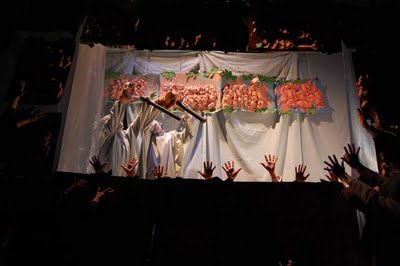
In the box stage, a pair of “stargazer” puppets with black tube telescopes stare across the stage – and then across a giant nude female torso that floats into the right side of the stage. Schumann plays violin as he recites: “Oh you stars, Oh you horses and tigers of the sky. … Oh you light of no meaning, Oh you singers of no songs, Oh you funny holy Nothingness, Oh you enormous belly, so pregnant and beautiful, I want to bend my knee and distort my neck to admire you forever and ever.”
An NPR reporter interviews a “money artists” (both costumed in Groucho Marx masks) about the meaning of the design of money. “It has no meaning,” the artist says. “We are money artists and the significance of our work derives from its aesthetic value mixed with its exchange value.” The artist slams her door in the face of the reporter.
The woman comes out of the chorus again and announces: “The fifth dance intervention is seven seven-second dances.” The chorus performs a series of group dances that resemble goofy exercises from a dance class. Some bend over, hold their ankles, and stop around. Some line up and move their arms like train gears. Etc.
Narrator announces a “Hocus-pocus parade with effigies of major and minor representatives of Heaven, including God, God’s daughter and stepdaughter.” Four costumed performers come out and perform a chain reaction dance. A finger bangs a drum on the back of a pink lady, who clashes a cymbal on her head with the one on the back of a monkey. Then the rooster at the front of the line crows.

The chorus sits in the middle of the stage and makes bird noises as a large Madonna and child puppet is slowly winched up (via a squeaky pulley – if something can squeak in a Bread and Puppet show is must squeak) to the ceiling at right. Her dress lifts to reveal a gray globe-egg, that splits open. Inside is a white puppet (operated by two cloaked performers bunraku style), “Heaven’s public relations specialist.” He says, “Allow me to bring to your attention the totally serious beauty of the ecstasy department’s activities, though behind closed doors. … Please make no attempt to grasp the glory of the non-existing angels in their endless diving swirlings and do not try to imagine their sexual wholesomeness expressed in diaphonic singing white penetrating each other … And as always, when the angels depart, their wings bring down the walls of the cages in which humans live. And as for the above-mentioned unbearable delights, they are displayed in the serious store-windows of our own high culture and are made available to the public again and again, but to no avail … And yet our highest aspirations are linked to exactly these serious store windows.”

In the box stage, behind the plastic curtain (now defined as a store window into heaven?), giant papier-mache heads and nude female torsos float, bathed by white and then blue spotlights that give the scene an otherworldly underwater feel. Then darkness. The scene is simple: some large roughhewn paper sculptures slowly waved about by hidden performers under dim lights. But the effect is magic, ancient campfire magic.
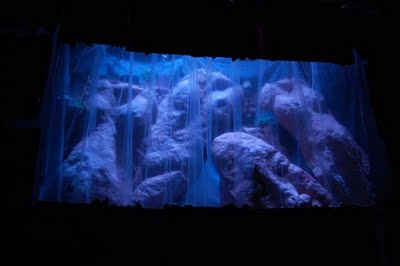
The woman from the chorus announces, “The last dance intervention is a sermon delivered by the deeply superstitious practitioners of the papier-mache religion.” Schumann stands behind a music stand in the center of the stage and declares as he saws on his violin. The chorus fills the back of the stage, improvising behind him – pointing to the ceiling, crouching down, hopping, pulling on their ties, leaning this way and that. “Papier-mache religion … unlike all other religions is not necessary and this its unnecessity is exactly what necessitates it,” Schumann says. “It emerges from the depth of nowhere at a time when the traditional religions don’t feel free to admit their unabashed righteousness and claim an absurd tolerance which directly contradicts their divine inspiration. Papier-mache religion simply says to them: please. However in the case of divinely inspired drone and F-16 bombardment you can’t say please and you appeal to the most hidden and unimportant part of the human brain, which produces reason. … [This section of the brain] pretends to supercede the excessive truth claims of religion only to eventually yield to the obviously religiously organized reality. … The bloodthirsty Greek gods or any wild gods of antiquity seem Christian compared with Christianity. Humanity’s collective babymind produces daddies in the sky and Satans in the innards of the earth to absolve the real daddies and Satans from their crimes. Religion is the nonsense that meaningless life needs in order to make sense. … Papier-machie religion is a generic all-purpose re-ligio, which means a tying back to the origin. Origin of what? Naturally of sky and papier-mache or of puppetry and daylight. … Hallelujah, amen, hurray, forever and ever, hocus pocus, Ta-ta-ta.” All the cast hops up and down. The end.
The numerous concerns raised by the show feel like a catalogue – God, mining by mountain top removal, Iraq, Gaza, etc. It doesn’t seem to build up to something, but rather places disparate things side by side. The most sustained – and moving – section is about the dead of Gaza, beginning with the Gaza banner and the white women, and including the soldier placing bodies, the lantern man examining them, the white woman with long hair trying to recessitate them, and when she fails, the bodies carried off in the wheelbarrow. The mood is broken by a series of absurdist comic acts and the pedantic jabbering of Heaven’s PR specialist. But those glimpses of floating giant heads and naked torsos and crowds of figures are ravishing. So it feels anticlimactic, a breaking of the spell – intentionally, I suppose – when Schumann concludes with his fiddle sermon, criticizing organized religions, in particular for obscuring the responsibility of polluters and warmongers and torturers for their deeds by projecting responsibility onto some abstract evil. But he seems to acknowledge humanity’s need for rituals that help us make sense of the world. He seemingly places himself, his company, in the position of prophet who damns society’s evil ways. His final speech is ultimately a defense of his puppet magic, and its pagan roots, and its power to heal our hearts.
Photos by The New England Journal of Aesthetic Research. You can purchase these and other Bread and Puppet photos here. And disclosure: We sold our photos of Bread and Puppet at the BCA during the troupe’s run, which is just one of the ways we might be biased in the company’s favor.
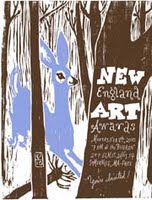 will be announced at the New England Art Awards Ball at 7 p.m. Monday, Feb. 8, 2010, at the Burren, 247 Elm St., Davis Square, Somerville, Massachusetts. As if that weren’t enticing enough, the terrific Second Line Social Aid and Pleasure Society Brass Band of Cambridge, Massachusetts, will open the ceremony. And you are invited!
will be announced at the New England Art Awards Ball at 7 p.m. Monday, Feb. 8, 2010, at the Burren, 247 Elm St., Davis Square, Somerville, Massachusetts. As if that weren’t enticing enough, the terrific Second Line Social Aid and Pleasure Society Brass Band of Cambridge, Massachusetts, will open the ceremony. And you are invited!





